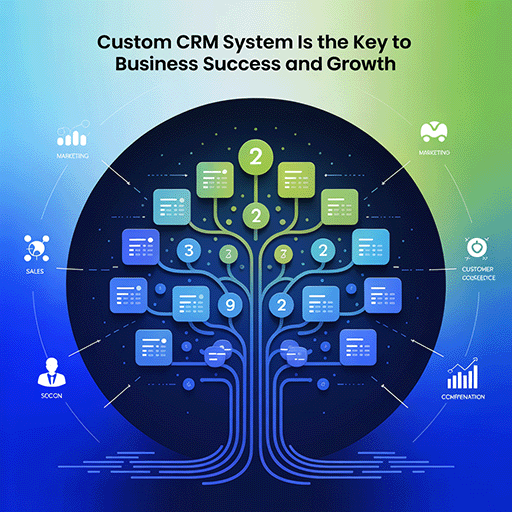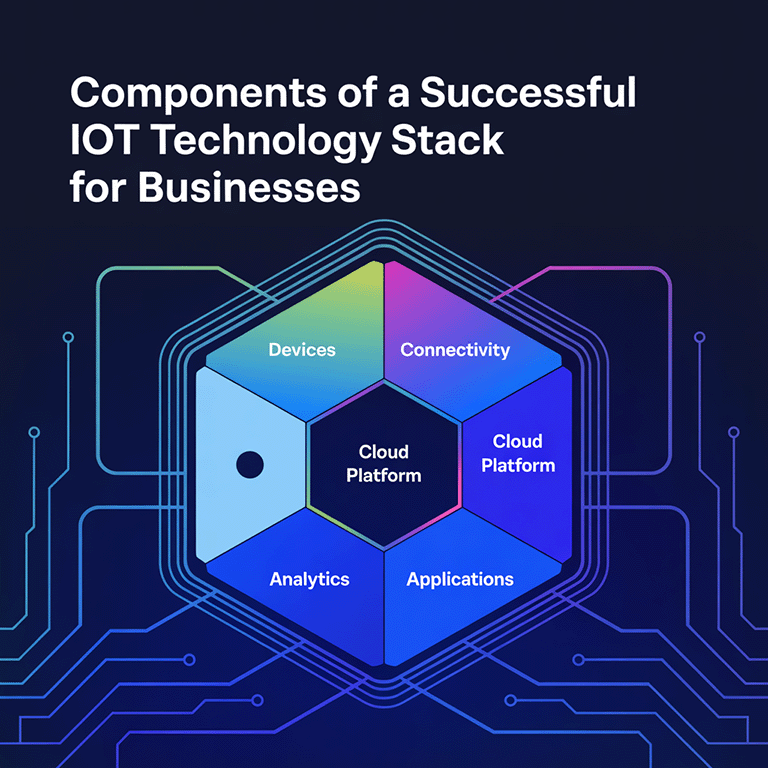Imagine a world where every factory, every machine, and even every product has a virtual counterpart that mirrors its real-life operations in real time. This is possible with digital twins in manufacturing. For instance, Siemens, a global technology powerhouse, leverages digital twins to simulate, predict, and optimize production processes, saving up to 30% in operational costs and reducing time-to-market by 50%.
A digital twin is a dynamic, virtual model of a physical asset, system, or process. It allows manufacturers to simulate, analyze, and improve operations without disrupting the real world. This concept isn’t just a futuristic dream; it’s a transformative tool already making waves in the industry. Multiple large industrial companies are expected to use digital twins to improve effectiveness.
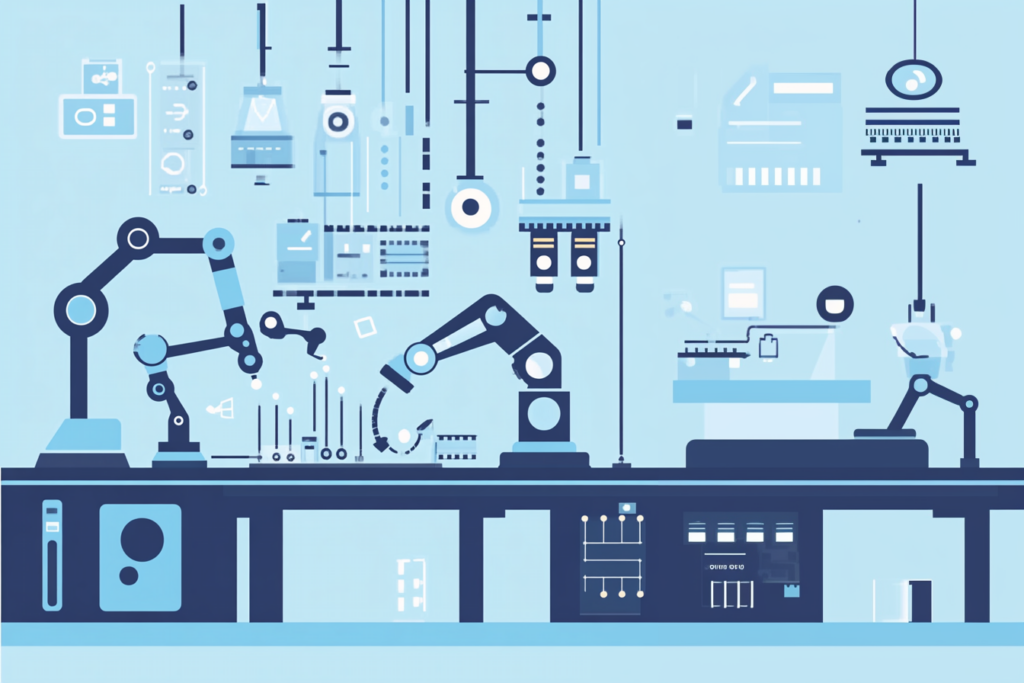
In this article, we’ll explore the fascinating world of digital twins in manufacturing and review 10 inspiring examples of how companies harness this technology to drive innovation and efficiency. Whether you’re a seasoned professional or just curious about the latest trends, these real-world applications will give you a glimpse into the future of manufacturing.
What is Digital Twin in Manufacturing?
The concept of digital twins may seem cutting-edge, but its roots can be traced back to the early days of computer-aided design (CAD) and simulation. The term “digital twin” was first coined by Dr. Michael Grieves at the University of Michigan in 2002. Initially, it was a theoretical framework, but technological advancements over the past two decades have transformed it into a practical, game-changing tool for the manufacturing industry. Want to know more about AI in manufacturing? Read our blog.
History and Evolution
The journey of digital twins began with the development of CAD, which allowed engineers to create detailed digital models of physical objects. As computing power increased and sensor technology advanced, these static models evolved into dynamic simulations that could interact with real-time data. By the early 2010s, digital twins started gaining traction in industries like aerospace and automotive, where complex systems and the need for high reliability made them an ideal fit.
A significant milestone came when NASA adopted digital twin technology to monitor and maintain its spacecraft, ensuring their safety and performance in the harsh environment of space. This high-profile application highlighted the potential of digital twins and spurred further adoption across various industries.
Key Components of Digital Twin
Digital twin technology is built on a foundation of several key components that work together to create a dynamic, real-time virtual model of a physical asset. Understanding these components is crucial to grasping how digital twins in manufacturing and other industries function and deliver their transformative benefits in manufacturing.
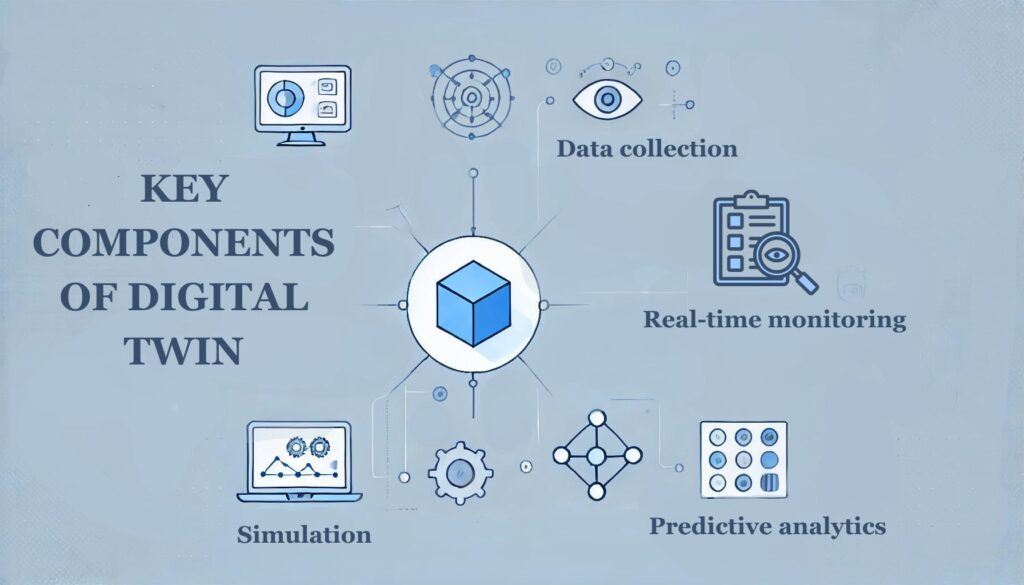
Data Collection
Data collection is the first and most critical component of digital twin technology. It involves gathering detailed information from the physical asset through a network of sensors. These sensors capture a variety of data points, including:
-
Temperature: Monitoring heat levels to prevent overheating and ensure optimal operation.
-
Pressure: Measuring internal and external pressures to maintain structural integrity and performance.
-
Vibration: Detecting unusual vibrations that might indicate mechanical issues or wear and tear.
-
Speed: Tracking the operational speed of machinery to ensure efficiency and safety.
-
Operational Status: Recording the on/off states, error codes, and other operational parameters.
This real-time data provides a comprehensive view of the physical asset’s condition and performance, forming the backbone of the digital twin model.
Real-Time Monitoring
Real-time monitoring is the continuous observation and tracking of the physical asset’s performance using the data collected. This component enables manufacturers to:
-
Detect Anomalies: Identify deviations from normal operating conditions that could indicate potential issues.
-
Monitor Performance: Keep track of key performance indicators (KPIs) to ensure the asset operates within the desired parameters.
-
Ensure Compliance: Verify that the asset meets regulatory standards and operational guidelines.
By providing a live data feed, real-time monitoring allows for immediate response to any irregularities, minimizing downtime and maintaining smooth operations.
Simulation
Simulation involves creating a virtual model of the physical asset using the real-time data collected. This digital replica can be used to:
-
Test Scenarios: Run various what-if scenarios to predict how the asset will behave under different conditions.
-
Optimize Processes: Identify the most efficient ways to operate and configure the asset to enhance performance.
-
Design Improvements: Experiment with design changes in the virtual environment before applying them to the physical asset, reducing the risk of costly errors.
Simulations help manufacturers understand potential outcomes and make data-driven decisions, enhancing overall efficiency and innovation.
Predictive Analytics
Predictive analytics is the application of statistical techniques and machine learning algorithms to analyze historical and real-time data from the digital twin. This component enables:
-
Predictive Maintenance: Forecast when components are likely to fail and schedule maintenance proactively to avoid unexpected breakdowns.
-
Performance Optimization: Identify trends and patterns that can be leveraged to optimize the asset’s performance.
-
Risk Management: Assess potential risks and implement strategies to mitigate them before they impact operations.
Predictive analytics transforms raw data into actionable insights, allowing manufacturers to anticipate and address issues before they occur, thereby enhancing reliability and reducing costs.
Market Predictions and Growth
Today, manufacturing digital twins are rapidly becoming mainstream. According to a report by MarketsandMarkets, the digital twin market is projected to grow from $10.1 billion in 2023 to $101.1 billion by 2028 at a compound annual growth rate (CAGR) of 61.3%. This growth is due to a rising need for predictive maintenance, the rise of Industry 4.0, and better IoT technologies.
Gartner predicts that by 2027, 45% of large industrial companies will use digital twins, resulting in increased revenue. This prediction underscores the transformative impact of digital twins on manufacturing efficiency and productivity.
Market Share and Adoption
The adoption of digital twins varies across industries, but manufacturing leads the way. A survey by Deloitte revealed that 15% of manufacturing executives plan to invest in digital twin technology within the next year. The automotive, aerospace, and industrial equipment sectors are particularly strong adopters, driven by the need for high precision and reliability.
In the automotive industry, companies like Tesla and BMW use digital twins to streamline production and enhance vehicle performance. In aerospace, giants like Boeing and Airbus rely on digital twins to design and maintain aircraft, ensuring safety and efficiency. Industrial equipment manufacturers, including Siemens and GE, utilize manufacturing digital twins to optimize machinery performance and reduce downtime. We’ll talk about even more inspiring examples below.
Key Digital Twin Benefits
Digital twin technology offers a myriad of benefits to the manufacturing sector, revolutionizing the way companies design, produce, and maintain their products. Here are some of the key advantages that manufacturing digital twins bring to the table:
Enhanced Predictive Maintenance: By analyzing real-time data, digital twins can predict equipment failures before they occur. This allows for timely maintenance and reduces unplanned downtime.
Improved Product Design and Quality: Digital twins enable manufacturers to test and validate new designs virtually while reducing the need for physical prototypes. This can speed up the design process and improve product quality by identifying potential issues early on.
Optimized Production Processes: By simulating different production scenarios, digital twins can help identify the most efficient processes, which leads to increased productivity and reduced operational costs.
Reduced Time-to-Market: With the ability to test and refine products and processes virtually, manufacturers can bring new products to market faster, cutting time-to-market by as much as 50%.
Sustainability and Resource Efficiency: Digital twins can optimize energy consumption and resource utilization, contributing to more sustainable manufacturing practices and reducing environmental impact.
How Does Digital Twin Work: Step by Step
Digital twins revolutionize manufacturing by creating virtual replicas of physical assets or systems. Here’s a detailed, step-by-step breakdown of how they work.
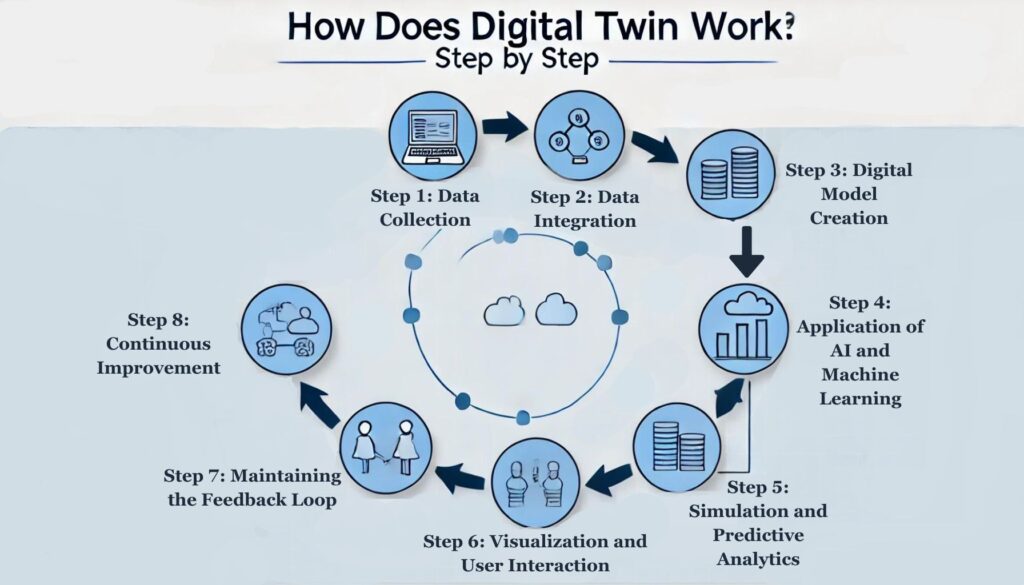
Step 1: Data Collection
The process starts with collecting data from the physical asset. A network of sensors is embedded in machinery, equipment, or processes to continuously capture a variety of information, such as:
-
Temperature
-
Pressure
-
Vibration
-
Speed
-
Other critical operational parameters
These sensors ensure that every aspect of the physical asset’s performance is monitored in real time.
Step 2: Data Integration
The collected sensor data is then integrated and processed through Internet of Things (IoT) platforms. These platforms perform several vital functions:
-
Aggregating data from multiple sensors
-
Ensuring real-time accessibility of the data
-
Facilitating seamless communication between the physical asset and its digital twin
This integration is crucial for maintaining an up-to-date and accurate digital replica.
Step 3: Digital Model Creation
Next, advanced simulation software is used to create the digital twin model. This involves:
-
Utilizing real-time data to construct a detailed virtual replica of the physical asset
-
Continuously updating the model to reflect any changes or anomalies detected in the physical counterpart
This digital model serves as the foundation for simulations and analysis.
Step 4: Application of AI and Machine Learning
Machine learning algorithms and artificial intelligence (AI) are employed to enhance the digital twin’s capabilities. These technologies:
-
Analyze historical and real-time data to identify patterns
-
Predict future performance and potential issues
-
Provide actionable insights based on data analysis
AI and machine learning enable the digital twin for manufacturing to offer predictive maintenance and performance optimization.
Step 5: Simulation and Predictive Analytics
Digital twins use predictive analytics to forecast potential issues and optimize performance. This step involves:
-
Running simulations in a virtual environment to test different scenarios
-
Predicting when maintenance is needed or when a component might fail
-
Planning maintenance schedules based on predictive insights to reduce downtime
These simulations allow manufacturers to experiment with various strategies without risking real-world disruptions.
Step 6: Visualization and User Interaction
A user-friendly interface is developed to enable interaction with the digital twin. Key features include:
-
Advanced visualization tools, such as 3D models and augmented reality (AR)
-
Real-time monitoring of data and performance metrics
-
The ability to run simulations and analyze outcomes
This interface ensures that stakeholders can easily understand and engage with the digital twin.
Step 7: Maintaining the Feedback Loop
A crucial aspect of digital twins is the continuous feedback loop between the physical and virtual worlds. This involves:
-
Mirroring changes in the physical asset within the digital twin
-
Using insights from the digital twin to optimize physical operations
-
Ensuring that the digital twin remains an accurate representation of the physical asset
This feedback loop is essential for maintaining operational efficiency and effectiveness.
Step 8: Continuous Improvement
Digital twins in manufacturing facilitate continuous improvement by providing a platform for ongoing monitoring and analysis. This step includes:
-
Identifying inefficiencies and areas for improvement
-
Testing new strategies and configurations in a risk-free virtual environment
-
Implementing changes based on insights gained from the digital twin
This iterative process drives innovation and enhances overall performance.
10 Inspiring Digital Twin Manufacturing Examples
Digital twins are transforming the manufacturing landscape by enabling companies to continuously optimize operations, reduce costs, and innovate. Here are ten detailed examples of companies effectively leveraging manufacturing digital twin technology.
1. Siemens

Siemens pioneered the use of digital twins, particularly at their Amberg Electronics Plant in Germany. The plant, which produces programmable logic controllers (PLCs), uses digital twin technology to create a virtual replica of the entire production process.
This digital replica includes everything from machine operations to production workflow. By simulating and optimizing these processes, Siemens has made significant progress, with a 30% increase in the ability to adjust manufacturing volumes, a 20% boost in productivity, and a 40% enhancement in space efficiency.
The digital twin also enables predictive maintenance, reducing unexpected equipment failures and extending the lifespan of their machinery. Additionally, Siemens can quickly adapt to changes in demand by adjusting the digital twin model and implementing changes in the physical plant with minimal disruption.
2. General Electric (GE)

GE uses manufacturing digital twins to monitor and maintain its fleet of jet engines. Each engine has a digital counterpart that tracks its performance and predicts maintenance needs based on real-time data collected from sensors. This proactive approach has reduced reactive maintenance by 40% and increased engine uptime, hence ensuring smoother operations and less downtime.
GE’s digital twin technology also aids in optimizing fuel efficiency and minimizing environmental impact, contributing to more sustainable aviation practices. By analyzing data from the digital twins, GE can identify patterns and predict potential issues. This allows for timely interventions and extending the engines’ operational life.
3. Tesla

Tesla utilizes digital twin technology to streamline manufacturing processes and enhance vehicle performance. Every Tesla car has a digital twin that collects data throughout its lifecycle, from production to daily use. This data helps Tesla improve vehicle designs, predict maintenance needs, and enhance customer satisfaction.
By analyzing data from their digital twins, Tesla can continuously update and refine their software, ensuring that each vehicle operates at peak performance and safety levels. Additionally, Tesla uses digital twins for manufacturing to optimize its production lines, reducing waste and increasing efficiency, which helps the company meet high demand while maintaining quality standards.
4. Boeing
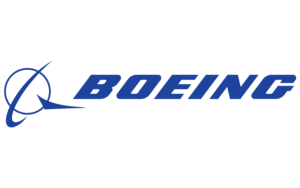
Digital twins also enable Boeing to perform virtual tests on new materials and designs, accelerating innovation and improving aircraft reliability and safety. The use of digital twins extends to in-service aircraft, where Boeing monitors performance data to ensure optimal operation and proactive maintenance.
5. Unilever
Additionally, digital twins help Unilever ensure consistency and quality across different production sites, maintaining high standards for their global product lines. For instance, digital twins allow Unilever to quickly adapt recipes and production methods to meet local tastes and regulatory requirements without compromising efficiency.
6. BMW

BMW leverages digital twin technology to enhance its vehicle manufacturing processes. Digital twins for manufacturing are used to simulate and optimize the assembly line, ensuring precision and efficiency. This approach has helped BMW reduce production errors and improve overall manufacturing quality.
BMW also uses digital twins to simulate vehicle performance under various conditions. In this way, engineers can make data-driven decisions that enhance vehicle safety and customer satisfaction. Besides, BMW’s digital twins assist in designing and testing new vehicle features and technologies, accelerating the development cycle and bringing innovative products to market faster.
7. Lockheed Martin

In the aerospace sector, Lockheed Martin uses digital twins to design and produce complex components. The technology allows engineers to simulate and test parts before manufacturing, ensuring they meet stringent performance and safety standards.
Digital twins also enable Lockheed Martin to conduct virtual maintenance training, improving the skills of technicians and reducing the time required for on-the-job training. Furthermore, manufacturing digital twins helps Lockheed Martin manage the entire lifecycle of their products, from initial design and testing to production and maintenance, ensuring optimal performance and reliability.
8. Procter & Gamble (P&G)

Procter & Gamble employs digital twins to optimize their supply chain and production processes. By simulating different supply chain scenarios, P&G can identify potential bottlenecks and inefficiencies. As a result, it led to an improvement in supply chain performance and reduced operational costs.
Digital twins also help P&G monitor and maintain the health of their production equipment, ensuring consistent product quality and reducing downtime. For example, P&G uses digital twins to model and optimize the production of consumer goods, such as shampoos and detergents, ensuring that each batch meets quality standards and production schedules are met.
9. Caterpillar

Caterpillar uses digital twins to monitor the performance of its heavy machinery in real time. The digital replicas track machine health and predict maintenance needs, helping to avoid unexpected breakdowns. This proactive maintenance approach has increased equipment uptime and reduced maintenance costs.
Caterpillar also leverages manufacturing digital twins to train operators on new equipment, enhancing their skills and overall operational safety and efficiency. Digital twins assist Caterpillar in designing and testing new machinery, ensuring that their products are reliable, efficient, and meet customer requirements.
10. Airbus

Airbus utilizes real-time data digital twin technology to improve the design and production of its aircraft. Digital twins simulate every aspect of the aircraft’s performance, from aerodynamics to system operations. This comprehensive approach has reduced rework by 20% and improved overall aircraft performance and safety.
Airbus also uses digital twins to streamline its supply chain and production processes, ensuring timely delivery and reducing costs associated with delays and rework. Furthermore, digital twins help Airbus monitor in-service aircraft, enabling predictive maintenance and ensuring its fleet operates efficiently and safely throughout its lifecycle.
In a Nutshell
Digital twins in manufacturing integrate real-time data, monitoring, simulation, and predictive analytics to provide unprecedented insights. Manufacturers can now anticipate issues, optimize operations, and make data-driven decisions that boost efficiency and cut costs.
Industry leaders like Siemens, GE, Tesla, and Boeing showcase the power of digital twins. They’ve improved in productivity, quality, maintenance, and overall effectiveness. By simulating scenarios and predicting maintenance needs, these companies have enhanced their competitiveness and driven innovation.
As digital twin adoption grows, experts predict it will become integral to manufacturing. The technology promises a brighter, more efficient future for the industry. Companies embracing digital twins can unlock new levels of performance and responsiveness, staying ahead in a complex, fast-paced environment.
Leverage digital twins to meet evolving market demands and shape a resilient industrial landscape. If you’re looking for an expert team of software developers, don’t hesitate to contact us!
FAQ
How does digital twin technology integrate with existing manufacturing systems?
Seamless integration with existing systems is a hallmark of digital twin technology. Our AI team tailors the process to your infrastructure, connecting via standard protocols and APIs. This adaptability lets digital twins tap into PLCs, SCADA, and ERP systems effortlessly. You’ll reap the rewards of this cutting-edge tech without disrupting your current setup. Digital twins pull data from diverse sources, enhancing your manufacturing processes while preserving existing investments. The result? A powerful fusion of old and new, driving efficiency and innovation in your operations.
What are the cybersecurity measures for digital twins?
Given that digital twins rely on real-time data and continuous connectivity, cybersecurity is a critical concern. Implementing end-to-end encryption, secure protocols, and frequent audits is effective. Stringent access controls and authentication safeguard your digital twin data. AI-powered algorithms vigilantly scan for threats, fortifying your operations. With these robust measures, your digital twin remains an impenetrable fortress, accessible only to those you trust.
How can digital twin technology be scaled across multiple manufacturing sites?
Scaling digital twin technology across multiple manufacturing sites involves creating standardized models and data protocols that can be replicated and adapted to different locations. Centralized data management systems, cloud-based solutions for remote access, and consistent training for staff at all locations are necessary to ensure smooth implementation and operation that can be easily deployed across various sites.
What kind of return on investment (ROI) can manufacturers expect from implementing digital twins?
Digital twin technology’s ROI hinges on process complexity, implementation scope, and application. Manufacturers typically reap substantial savings through minimized downtime, streamlined maintenance, enhanced quality, and boosted efficiency. You can also apply customized ROI analyses to illuminate potential financial gains for your unique operations. Results vary, but the technology’s impact on manufacturing performance is undeniable.
How long does it take to implement a digital twin solution in a manufacturing environment?
The timeline for implementing a digital twin solution can vary based on the complexity of the project and the readiness of the existing infrastructure. Typically, this focused approach jumpstarts the process, allowing for rapid expansion once proven successful. We collaborate closely with clients, offering continuous support to fine-tune the system. Implementation timelines flex based on project scope and existing infrastructure, but our phased method ensures efficient rollout. From initial testing to full-scale deployment, we guide clients through each step, adapting as needed to deliver optimal results across assets and processes.


